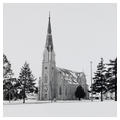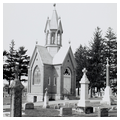Because of its hilltop situation, the Roman Catholic church of Saint Boniface dominates the small town and surrounding countryside. The New Vienna church, like the one at nearby Dyersville, is French Gothic in inspiration, even though it too was built by German immigrants. Saint Boniface is entirely of stone, a white magnesia limestone obtained from a nearby quarry. Externally the side aisles appear to be separate from the higher nave section; small wall-dormer windows provide clerestory lighting for the nave. The single entrance tower with its narrow spire is 200 feet high. The simple interior, with its thin coupled columns, centers on a finely carved mahogany altar. In the adjoining cemetery is a playhouse-sized cruciform chapel (1900) crowned by an open six-sided tower at the crossing. The tower, its roof, and the roof of the chapel are sheathed in shimmering metal shingles.
You are here
Saint Boniface Roman Catholic Church
If SAH Archipedia has been useful to you, please consider supporting it.
SAH Archipedia tells the story of the United States through its buildings, landscapes, and cities. This freely available resource empowers the public with authoritative knowledge that deepens their understanding and appreciation of the built environment. But the Society of Architectural Historians, which created SAH Archipedia with University of Virginia Press, needs your support to maintain the high-caliber research, writing, photography, cartography, editing, design, and programming that make SAH Archipedia a trusted online resource available to all who value the history of place, heritage tourism, and learning.

















